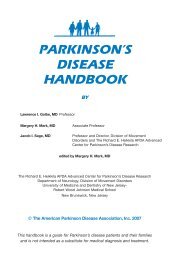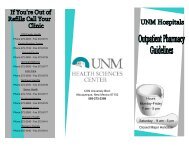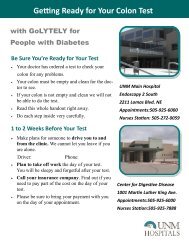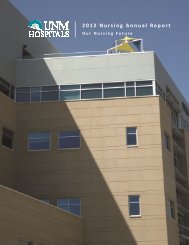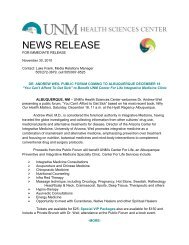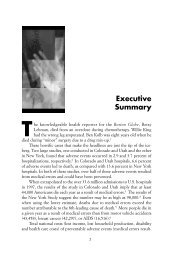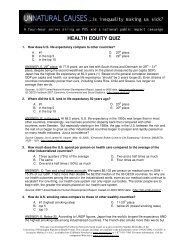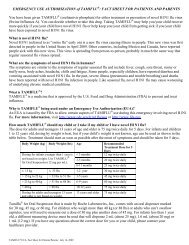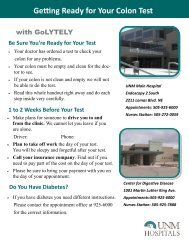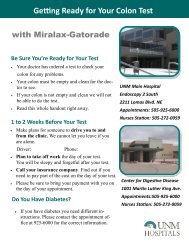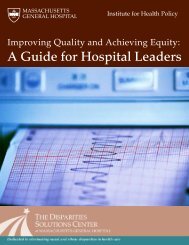Advanced Effective Communication, Cultural Competence, and ...
Advanced Effective Communication, Cultural Competence, and ...
Advanced Effective Communication, Cultural Competence, and ...
You also want an ePaper? Increase the reach of your titles
YUMPU automatically turns print PDFs into web optimized ePapers that Google loves.
A Roadmap for Hospitals<br />
Appendix B: Current Joint Commission Requirements<br />
Emergency Management (EM)<br />
The Joint Commission’s EM st<strong>and</strong>ards provide guidance to<br />
hospitals about how to plan for <strong>and</strong> respond to potential<br />
emergencies. While these st<strong>and</strong>ards do not explicitly address<br />
effective communication, cultural competence, <strong>and</strong> patient<strong>and</strong><br />
family-centered care, it is necessary to consider the<br />
diverse needs of the patient <strong>and</strong> community population so<br />
that emergency response efforts provide for the safety of all<br />
who require hospital services (see box, right). For example,<br />
decontamination instructions provided to patients by staff<br />
should not only be verbal, but should also be in the form of<br />
posters or other visual aides for patients who are deaf or have<br />
limited English proficiency.<br />
The hospital may also want to consider ethnic media as<br />
sources for communicating information to minority<br />
populations. The “vulnerable populations” referenced<br />
in St<strong>and</strong>ard EM. 02.02.11, EP 4, may also include<br />
individuals with limited English proficiency or other<br />
communication needs.<br />
Human Resources (HR)<br />
Many recommendations to promote effective communication,<br />
cultural competence, <strong>and</strong> patient- <strong>and</strong> family-centered<br />
care include recommendations to build a diverse workforce<br />
through recruitment, retention, <strong>and</strong> promotion of diverse<br />
staff. The Joint Commission st<strong>and</strong>ards do not set this specific<br />
expectation. Instead, Joint Commission st<strong>and</strong>ards expect that<br />
hospital staffing is consistent with the organization’s mission.<br />
In addition, The Joint Commission expects the organization’s<br />
leadership to define the qualifications <strong>and</strong> competencies of<br />
staff (see Leadership on page 51).<br />
From this perspective, HR st<strong>and</strong>ards focus mainly on the<br />
specific skill sets <strong>and</strong> competencies that staff need to perform<br />
their job. Joint Commission st<strong>and</strong>ards address orientation on<br />
cultural diversity <strong>and</strong> sensitivity, <strong>and</strong> expect ongoing in-services<br />
<strong>and</strong> other education <strong>and</strong> training to be appropriate to the needs<br />
of the population(s) served <strong>and</strong> responsive to learning needs<br />
identified through performance improvement findings <strong>and</strong><br />
other data analysis (see box, page 51). Staff must be aware of<br />
relevant policies <strong>and</strong> procedures, which could include the<br />
hospital’s policies for meeting patient communication needs.<br />
<strong>Communication</strong> is recognized as a patient right, but is also<br />
clearly part of the provision of safe care. It is vital to make staff<br />
aware of how to identify <strong>and</strong> address patient communication<br />
needs within the scope of their job duties.<br />
Joint Commission EM Requirements<br />
EM.02.02.01 As part of its Emergency Operations<br />
Plan, the hospital prepares for how it will<br />
communicate during emergencies.<br />
Rationale for EM.02.02.01<br />
The hospital maintains reliable communications capabilities<br />
for the purpose of communication response efforts to staff,<br />
patients, <strong>and</strong> external organizations. The hospital<br />
establishes backup communications processes <strong>and</strong><br />
technologies (for example, cell phones, l<strong>and</strong> lines, bulletin<br />
boards, fax machines, satellite phones, Amateur Radio, text<br />
messages) to communicate essential information if primary<br />
communication systems fail.<br />
EP 5 The Emergency Operations Plan describes the<br />
following: How the hospital will communicate with<br />
patients <strong>and</strong> their families, including how it will notify<br />
families when patients are relocated to alternative<br />
care sites.<br />
EP 6 The Emergency Operations Plan describes the<br />
following: How the hospital will communicate with the<br />
community or the media during an emergency.<br />
EM.02.02.11 As part of its Emergency Operations<br />
plan, the hospital prepares for how it will manage<br />
patients during emergencies.<br />
Rationale for EM.02.02.11<br />
The fundamental goal of emergency management<br />
planning is to protect life <strong>and</strong> prevent disability. The<br />
manner in which care, treatment, <strong>and</strong> services are<br />
provided may vary by type of emergency. However, certain<br />
activities are so fundamental to patient safety (this can<br />
include decisions to modify or discontinue services, make<br />
referrals, or transport patients) that the organization<br />
should take a proactive approach in considering how they<br />
might be accomplished.<br />
The emergency triage process will typically result in<br />
patients being quickly treated <strong>and</strong> discharged, admitted for<br />
a longer stay, or transferred to a more appropriate source<br />
of care.<br />
EP 4 The Emergency Operations Plan describes the<br />
following: How the hospital will manage a potential<br />
increase in dem<strong>and</strong> for clinical services for vulnerable<br />
populations served by the hospital, such as patients<br />
who are pediatric, geriatric, disabled, or have serious<br />
chronic conditions or addictions.<br />
It may also be appropriate to provide staff training on the<br />
cultural health beliefs <strong>and</strong> practices of the patient population<br />
if they differ from those of staff. In addition to having a<br />
diverse patient population, many hospitals also operate with a<br />
diverse staff <strong>and</strong> medical staff. Training <strong>and</strong> coaching to<br />
50



